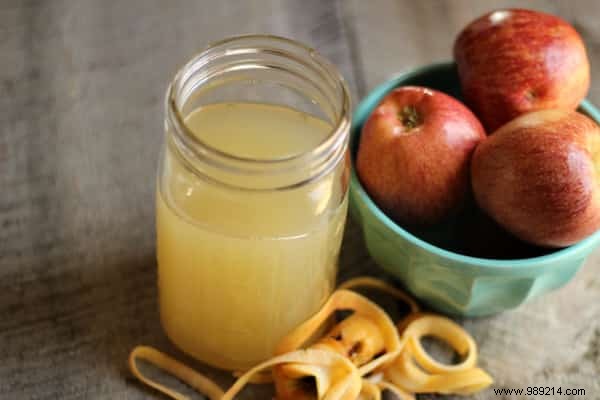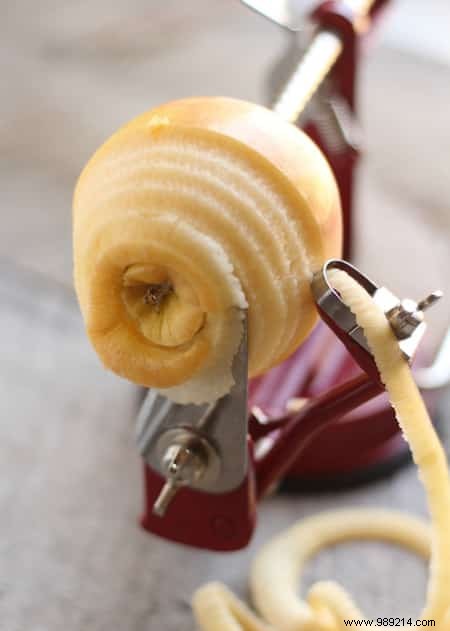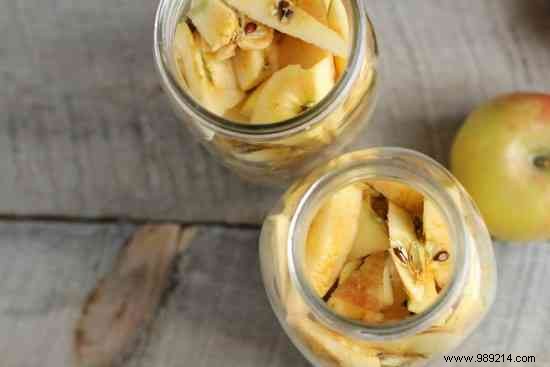
Nothing better than making your own products!
Apple cider vinegar is one of those products that you can easily make yourself :-)
What if I tell you that it will cost you next to nothing , that's even better, isn't it?
Especially since cider vinegar is far from cheap! Here, all you need are leftover apples.
With this homemade recipe, you will save money and you know what you are putting in it. Watch:

I confess that I am an unconditional fan of cider vinegar. I use it for everything:cleaning, cooking, pet care and everything in between.
And its health benefits are truly amazing. Recipes, there are several, but today I will show you how to make it from leftover apples.
I particularly like this method, because it allows me not to mess anything up. When you make a compote, for example, you use the fruit for your dessert and the peels and cores for the vinegar. There is no loss!
And what's more, it's very easy to make... and since I'm a big lazy person, this recipe suits me well.

- apple peels
- apple cores
- a tablespoon of sugar for 230 ml of water
- water
- a glass jar (1 liter is good to start with, but you can make more later).
1. Peel the apples. Me, I love this machine to peel them quickly.

2. Fill ¾ of the glass jar with unused apple peels, cores and pieces.

3. Add the sugar and mix in the water until it is completely dissolved.
4. Pour the water to completely cover the apple pieces. Leave some room at the top of the pot.
5. Cover the jar with a piece of cloth or coffee filter held with a rubber band.
6. Place the jar in a warm, dark place for about two weeks.
7. You can stir the mixture every 3-4 days, if you wish. If brownish/grayish scum develops on top, simply skim it off.
8. After two weeks, strain the liquid. Apple scraps must be removed (they can still go in the composter).
9. At this stage, the vinegar usually has a pleasant smell of apple cider, but it still lacks its characteristic taste.
10. Then set the filtered liquid aside for 2 to 4 weeks.

There you go, your homemade cider vinegar is already ready :-)
Now you know how to make apple cider vinegar.
You see when I told you that making apple vinegar was easy, it wasn't a joke!
You'll know your apple cider vinegar is ready once it has that unique vinegary smell and taste. If not, set the jar aside a little longer.
Once you are happy with the taste of your apple cider vinegar, seal it tightly and store it in the fridge for as long as you want. Don't worry, it won't expire!
If a gelatinous film develops on the top of your vinegar, congratulations! You have created a "mother of vinegar". This mother can be used as a base to restart the manufacture of future jars of vinegar.
You can remove it and store it separately. Personally, I usually let it float in the jar of vinegar.
You can use your homemade vinegar just like you would store-bought vinegar!
You can use it for cooking, cleaning, and everything in between (including as a slimming ingredient)!
To discover: 18 Apple Cider Vinegar Uses No One Knows About.

- If your family does not like apple peels in homemade desserts, making this vinegar is ideal to avoid waste.
- You can use anything to make your vinegar:slightly bruised or blackened pieces of apple, peels or cores. Avoid rotten or moldy fruit though.
- Don't have enough apples to fill a jar? No problem ! Place your pieces in the freezer until you have enough to fill the jar.
- As we use the peels for this recipe, I highly recommend using organic apples to avoid pesticides and chemical residues.
- You can use honey instead of sugar in this recipe. However, the honey will slow the process down a bit. Also, keep in mind that living organisms will eat the sugar throughout the fermentation process, so there will be little sugar in the final product.
- You can make as much vinegar as you want. The 1st time, I made a 300 ml jar, now I make big jars of several liters!
- You can also experiment with other fruit peels such as pears and peaches.
- Concerning pickles that you could make, be aware that this type of homemade vinegar should not be used as a conversation liquid. Because to do that, you need a vinegar with 5% acetic acid. Since we do not have the means to check the acidity level of our homemade vinegar, it is best to avoid making storage jars with this vinegar. Prevention is better than cure!